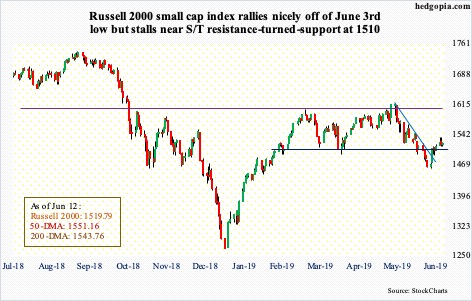Major US equity indices are stalling. They rallied ferociously after bottoming on June 3 and are probably in need of digestion. Some rallies they put up in seven sessions! Intraday between that low and Tuesday’s high, the S&P 500 large cap index jumped 6.6 percent, the Nasdaq 100 index 9.5 percent and the Russell 2000 small cap index 5.2 percent. This was preceded by a one-month decline starting May 1.
This week, sellers showed up at/near important levels.
During the one-week uptrend, both the S&P 500 and the Nasdaq 100 rallied past their 200-day moving average as well as the 50-day. The S&P 500 (2879.84) is still above the latter, but barely. Wednesday, the average (2873.18) was tested – successfully thus far. The index also faced resistance at 2890s. Both Monday and Tuesday, the Nasdaq 100 (7472.29) reclaimed the 50-day (7530.45) intraday but was unable to close above. Of the three, the Russell 2000 (1519.79) continues to be the laggards – below both the 50- and 200-day. It is still above short-term support at 1505-1510, but barely.
The daily is extended on all these three indices, which is not surprising given the sharp rally. The best bulls can hope for near term is that they are able to defend shorter-term averages, which are now beginning to turn up. Otherwise, the 200-day can be tested – 2775.27 on the S&P 500 and 7148.61 on the Nasdaq 100. Worse, bears would love to test the lows from early this month – 2728.81 on the S&P 500, 6936.68 on the Nasdaq 100 and 1460.49 on the Russell 2000 (chart above). On all these three, the lows approximate the daily lower Bollinger band.
In a scenario in which downward pressure is more likely than upside in the near term but things may not completely fall out of bed, a hypothetical calendar spread involving IWM (iShares Russell 2000 ETF) would look like this.
IWM June 28th/July 12th 151 calendar spread:
- Sell June 28th 151 call at $2.49
- Long July 12th 151 call at $3.34
It is a debit spread, costing $0.85, which is what is at risk. The ETF ($151.47) got rejected at the 200-day ($153.54) the past couple of sessions. Ideally, it drops in the next couple of weeks. The goal is to profit from time and volatility, taking advantage of accelerating time decay on the front-month call. If this scenario pans out, just before expiration, the short call can be bought back for next to nothing, while selling the back-month which would still have two weeks of time value left.
Thanks for reading!

